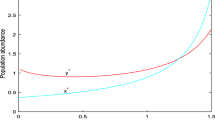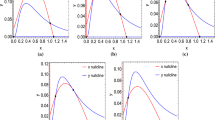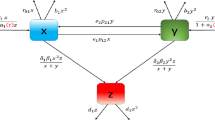Abstract
The present pursuit is focused on the influence of both the facets of fear and Allee on the dynamic feedback of the model system of interacting species. Apart from the consideration of intra-specific competition of both species to make more dynamic intricacy, the ratio-dependent functional response is taken into account for the ecological compatibility of the system. The usage of the additive Allee effect helps one to estimate the impact on the interactions of predator and prey species. The particular circumstances for the extinction of both species are discussed based on the establishment of fundamental mathematical concepts necessary for the system. The existence of ecologically significant equilibria, including their stability, is explored. In spite of having a ratio-dependent functional response, the response of the system in proximity to the origin is examined by pursuing a particular method duly modified. The mandatory analytical parametric conditions for the stability criteria of the system are validated numerically through the exhibition of results obtained. The main finding of this research is that in a system of interacting species, fear and Allee may produce codimension 1 and 2 bifurcation structures. For parameter values within the bifurcating domain, additional theoretical dynamics are also formed and are clearly explored in the present research. The system experiences all possible local and global bifurcations including Hopf, saddle-node, Bautin, Bogdanov–Takens, and homoclinic subject to the combined influence of fear and Allee factors. The first Lyapunov number is made use of to analyse the stability of the Hopf-bifurcating limit cycle. The impact of fear and Allee effect around the coexistence equilibrium of the system is not ruled out, however, to examine from the present system. The sensitivity analysis of the model parameters with respect to fixed coexistence is also performed comprehensively. The numerical simulations are carried out finally for the purpose of validation of the present theoretical outcomes with supportive numerical counterparts and its application in the realm of ecology in the future.


















Similar content being viewed by others
Data Availability Statement
Data sharing does not apply to this article as no dataset and code were generated or analyzed during the current study.
References
A.J. Lotka, Elements of Physical Biology (Williams & Wikins, Philadelphia, 1925)
V. Volterra, Fluctuations in the abundance of a species considered mathematically. Nature 118(2972), 558–560 (1926)
H.I. Freedman, Deterministic Mathematical Models in Population Ecology (Marcel Dekker Incorporated, New York, 1980)
G.F. Gause, The Struggle for Existence (Williams and Wilkins, Baltimore, 1935)
A.D. Bazykin, A.I. Khibnik, B. Krauskopf, Nonlinear Dynamics of Interacting Populations (World Scientific Publishing Company Incorporated, Singapore, 1998)
A.D. Bazykin, Structural and Dynamic Stability of Model Predator-Prey Systems (International Institute for Applied Systems Analysis, Laxenburg, 1976)
Y. Kuznetsov, Elements of Applied Bifurcation Theory (Springer, New York, 1998)
A.D. Bazykin, F.S. Brezovskaya, T.I. Buriev, Dynamics of predator-prey system including predator saturation and competition, Faktory Raznoobraziya v Matematicheskoi Ekologii i Populyatsionnoi Genetike, Pushchino, 6–33 (1980)
J. Hainzl, Stability and Hopf bifurcation in a predator-prey system with several parameters. SIAM J. Appl. Math. 48(1), 170–190 (1988)
G. Seo, M. Kot, A comparison of two predator-prey models with Holling’s type I functional response. Math. Biosci. 212(2), 161–179 (2008)
G. Seo, D.L. DeAngelis, A predator-prey model with a Holling type I functional response including a predator mutual interference. J. Nonlinear Sci. 21(6), 811–833 (2011)
R.E. Kooij, A. Zegeling, Predator-prey models with non-analytical functional response. Chaos Solitons Fractals 123, 163–172 (2019)
R.M. May, Stability and Complexity in Model Ecosystems (Princeton University Press, Princeton, 1973)
S.B. Hsu, On global stability of a predator-prey system. Math. Biosci. 39(1–2), 1–10 (1978)
L.P. Liu, K.S. Cheng, On the uniqueness of a limit cycle for a predator-prey system. SIAM J. Math. Anal. 19(4), 867–878 (1988)
Y. Kuang, H.I. Freedman, Uniqueness of limit cycles in Gause-type models of predator-prey systems. Math. Biosci. 88(1), 67–84 (1988)
H.I. Freedman, G.S.K. Wolkowicz, Predator-prey systems with group defence: the paradox of enrichment revisited. Bull. Math. Biol. 48(5–6), 493–508 (1986)
Y. Lamontagne, C. Coutu, C. Rousseau, Bifurcation analysis of a predator-prey system with generalised Holling type III functional response. J. Dyn. Differ. Equ. 20(3), 535–571 (2008)
G.S.K. Wolkowicz, Bifurcation analysis of a predator-prey system involving group defence. SIAM J. Appl. Math. 48(3), 592–606 (1988)
F. Rothe, D.S. Shafer, Multiple bifurcation in a predator-prey system with nonmonotonic predator response. Proc. Roy. Soc. Edinburgh Sect. A Math. 120(3–4), 313–347 (1992)
D. Xiao, S. Ruan, Global analysis in a predator-prey system with nonmonotonic functional response. SIAM J. Appl. Math. 61(4), 1445–1472 (2001)
H. Zhu, C.S.A. Campbell, G.S. Wolkowicz, Bifurcation analysis of a predator-prey system with nonmonotonic functional response. SIAM J. Appl. Math. 63(2), 636–682 (2003)
J.C. Huang, D.M. Xiao, Analyses of bifurcations and stability in a predator-prey system with Holling type-IV functional response. Acta Math. Appl. Sin. 20(1), 167–178 (2004)
C. Li, H. Zhu, Canard cycles for predator-prey systems with Holling types of functional response. J. Differ. Equ. 254(2), 879–910 (2013)
P. Turchin, Complex Population Dynamics (Princeton University Press, Princeton, 2013)
R.J. Taylor, Predation (Chapman and Hall, London, 1984)
J.B. Collings, The effects of the functional response on the bifurcation behavior of a mite predator-prey interaction model. J. Math. Biol. 36(2), 149–168 (1997)
R. Arditi, L.R. Ginzburg, Coupling in predator-prey dynamics: ratio-dependence. J. Theor. Biol. 139(3), 311–326 (1989)
M. Haque, Ratio-dependent predator-prey models of interacting populations. Bull. Math. Biol. 71(2), 430–452 (2009)
Z. Eskandari, Z. Avazzadeh, R. K. Ghaziani, Theoretical and numerical bifurcation analysis of a predator-prey system with ratio-dependence. Math. Sci. 1–12 (2023)
P. Justin, M. Clinchy, L.M. Dill, D. Roberts, L.Y. Zanette, Fear of large carnivores causes a trophic cascade. Nat. Commun. 7(1), 1–7 (2016)
X. Wang, L. Zanette, X. Zou, Modelling the fear effect in predator-prey interactions. J. Math. Biol. 73(5), 1179–1204 (2016)
X. Wang, X. Zou, Modeling the fear effect in predator-prey interactions with adaptive avoidance of predators. Bull. Math. Biol. 79(6), 1325–1359 (2017)
Y. Li, M. He, Z. Li, Dynamics of a ratio-dependent Leslie-Gower predator-prey model with Allee effect and fear effect. Math. Comput. Simul. 201, 417–439 (2022)
D. Pal, D. Kesh, D. Mukherjee, Qualitative study of cross-diffusion and pattern formation in Leslie-Gower predator-prey model with fear and Allee effects. Chaos Solitons Fractals 167, 113033 (2023)
M. Chen, Y. Takeuchi, J.F. Zhang, Dynamic complexity of a modified Leslie–Gower predator-prey system with fear effect. Commun. Nonlinear Sci. Numer. Simul., 107109 (2023)
G. Mandal, N. Ali, L.N. Guin, S. Chakravarty, Impact of fear on a tri-trophic food chain model with supplementary food source. Int. J. Dyn. Control, 1–34 (2023)
W. Cresswell, Predation in bird populations. J. Ornithol. 152(1), 251–263 (2011)
N. Pettorelli, T. Coulson, S.M. Durant, J.-M. Gaillard, Predation, individual variability and vertebrate population dynamics. Oecologia 167(2), 305–314 (2011)
S. Creel, D. Christianson, Relationships between direct predation and risk effects. Trends in Ecology & Evolution 23(4), 194–201 (2008)
A.J. Wirsing, W.J. Ripple, A comparison of shark and wolf research reveals similar behavioral responses by prey. Front. Ecol. Environ. 9(6), 335–341 (2011)
M.J. Sheriff, C.J. Krebs, R. Boonstra, The sensitive hare: sublethal effects of predator stress on reproduction in snowshoe hares. J. Anim. Ecol. 78(6), 1249–1258 (2009)
L.Y. Zanette, A.F. White, M.C. Allen, M. Clinchy, Perceived predation risk reduces the number of offspring songbirds produce per year. Science 334(6061), 1398–1401 (2011)
X. Wang, L. Zanette, X. Zou, Modelling the fear effect in predator-prey interactions. J. Math. Biol. 73(5), 1179–1204 (2016)
J. Wang, Y. Cai, S. Fu, W. Wang, The effect of the fear factor on the dynamics of a predator-prey model incorporating the prey refuge. Chaos Interdiscip. J. Nonlinear Sci. 29(8), 083109 (2019)
S. Samaddar, M. Dhar, P. Bhattacharya, Effect of fear on prey-predator dynamics: exploring the role of prey refuge and additional food. Chaos Interdiscip. J. Nonlinear Sci. 30(6), 063129 (2020)
R. Han, L.N. Guin, B. Dai, Cross-diffusion-driven pattern formation and selection in a modified Leslie–Gower predator-prey model with fear effect. J. Biol. Syst. 28(01), 27–64 (2020)
W.C. Allee, Animal Aggregations. A Study in General Sociology (University of Chicago Press, Chicago, 1933)
F. Courchamp, T. Clutton-Brock, B. Grenfell, Inverse density dependence and the Allee effect. Trends Ecol. Evolut. 14(10), 405–410 (1999)
P. Stephens, W. Sutherland, R. Freckleton, What is the Allee effect? Oikos, 185–190 (1999)
P.A. Stephens, W.J. Sutherland, Consequences of the Allee effect for behaviour, ecology and conservation. Trends Ecol. Evolut. 14(10), 401–405 (1999)
F. Courchamp, L. Berec, J. Gascoigne, Allee Effects in Ecology and Conservation (Oxford University Press, New York, 2008)
L.A. Dugatkin, Cooperation Among Animals: An Evolutionary Perspective (Oxford University Press, New York, 1997)
A.M. Kramer, B. Dennis, A.M. Liebhold, J.M. Drake, The evidence for Allee effects. Popul. Ecol. 51(3), 341–354 (2009)
S.D. Gregory, C.J. Bradshaw, B.J. Brook, F. Courchamp, Limited evidence for the demographic Allee effect from numerous species across taxa. Ecology 91(7), 2151–2161 (2010)
W.Z. Lidicker, The Allee effect: its history and future importance. Open Ecol. J., 3(1) (2010)
S.R. Zhou, Y.F. Liu, G. Wang, The stability of predator-prey systems subject to the Allee effects. Theor. Popul. Biol. 67(1), 23–31 (2005)
F. Courchamp, B. Grenfell, T. Clutton-Brock, Impact of natural enemies on obligately cooperative breeders. Oikos 91(2), 311–322 (2000)
A. Kent, C. Patrick Doncaster, T. Sluckin, Consequences for predators of rescue and Allee effects on prey. Ecol. Model. 162(3), 233–245 (2003)
L.N. Guin, G. Mandal, M. Mondal, S. Chakravarty, A chaotic tri-trophic food chain model supplemented by Allee effect. Int. J. Dyn. Control, 1–27 (2022)
M. Liermann, R. Hilborn, Depensation: evidence, models and implications. Fish Fish. 2(1), 33–58 (2001)
A.M. De Roos, L. Persson, Size-dependent life-history traits promote catastrophic collapses of top predators. Proc. Natl. Acad. Sci. 99(20), 12907–12912 (2002)
A.M. De Roos, L. Persson, H.R. Thieme, Emergent Allee effects in top predators feeding on structured prey populations. Proc. Roy. Soc. Lond. Ser. B Biol. Sci. 270(1515), 611–618 (2003)
A. Verdy, Modulation of predator-prey interactions by the Allee effect. Ecol. Model. 221(8), 1098–1107 (2010)
D.H. Brown, H. Ferris, S. Fu, R. Plant, Modeling direct positive feedback between predators and prey. Theor. Popul. Biol. 65(2), 143–152 (2004)
L. Berec, Impacts of foraging facilitation among predators on predator-prey dynamics. Bull. Math. Biol. 72(1), 94–121 (2010)
E.D. Conway, J.A. Smoller, Global analysis of a system of predator-prey equations. SIAM J. Appl. Math. 46(4), 630–642 (1986)
V. Van, A.K. George, L. Hemerik, M.P. Boer, B.W. Kooi, Heteroclinic orbits indicate overexploitation in predator-prey systems with a strong Allee effect. Math. Biosci. 209(2), 451–469 (2007)
C.W. Clark, Mathematical bioeconomics. Math. Prob. Biol., 29–45 (1974)
C.W. Clark, The Worldwide Crisis in Fisheries: Economic Models and Human Behavior (Cambridge University Press, Cambridge, 2006)
L. Perko, Differential Equations and Dynamical Systems (Springer, New York, 2001)
S. Wiggins, Introduction to Applied Nonlinear Dynamical Systems and Chaos (Springer, New York, 2003)
N. Chitnis, J.M. Hyman, J.M. Cushing, Determining important parameters in the spread of malaria through the sensitivity analysis of a mathematical model. Bull. Math. Biol. 5, 1272–1296 (2008)
M.D. Samsuzzoha, M. Singh, D. Lucy, Uncertainty and sensitivity analysis of the basic reproduction number of a vaccinated epidemic model of influenza. Appl. Math. Model. 37(3), 903–915 (2014)
A.F. Nindjin, M.A. Aziz-Alaoui, M. Cadivel, Analysis of a predator-prey model with modified Leslie–Gower and Holling-type II schemes with time delay. Nonlinear Anal. Real World Appl. 7(5), 1104–1118 (2006)
S. Mondal, A. Maiti, G.P. Samanta, Effects of fear and additional food in a delayed predator-prey model. Biophys. Rev. Lett. 13(04), 157–177 (2018)
S. Mondal, G.P. Samanta, Impact of fear on a predator-prey system with prey-dependent search rate in deterministic and stochastic environment. Nonlinear Dyn. 104(3), 2931–2959 (2021)
L.N. Guin, R. Murmu, H. Baek, K.H. Kim, Dynamical analysis of a Beddington–DeAngelis interacting species system with prey harvesting. Math. Prob. Eng. 2020 (2020)
L.N. Guin, P.K. Mandal, Spatiotemporal dynamics of reaction-diffusion models of interacting populations. Appl. Math. Model. 38(17–18), 4417–4427 (2014)
L.N. Guin, S. Acharya, Dynamic behaviour of a reaction-diffusion predator-prey model with both refuge and harvesting. Nonlinear Dyn. 88(2), 1501–1533 (2017)
R. Han, G. Mandal, L.N. Guin, S. Chakravarty, Dynamical response of a reaction–diffusion predator-prey system with cooperative hunting and prey refuge. J. Stat. Mech: Theory Exp. 2022(10), 103502 (2022)
L.N. Guin, Existence of spatial patterns in a predator-prey model with self-and cross-diffusion. Appl. Math. Comput. 226, 320–335 (2014)
L.N. Guin, B. Mondal, S. Chakravarty, Existence of spatiotemporal patterns in the reaction–diffusion predator-prey model incorporating prey refuge. Int. J. Biomath. 9(06), 1650085 (2016)
H.I. Freedman, S.G. Ruan, Uniform persistence in functional differential equations. J. Differ. Equ. 115(1), 173–192 (1995)
Acknowledgements
All the authors wish to express their sincere gratitude to the journal editors and the reviewers for the insightful criticism. The first author Mr. G. Mandal thankfully acknowledges the Council of Scientific and Industrial Research (CSIR), Government of India, New Delhi, for financial support in the form of a Junior Research Fellowship (File No.: 09/0202(16462)/2023-EMR-I Dated 14.03.2023).
Author information
Authors and Affiliations
Corresponding author
Ethics declarations
Conflict of interest
The authors declare that they have no conflicts of interest.
Appendices
Appendix
A Basic model analysis
This section deals with the basic preliminaries of the proposed model system (2.3), such as positivity and uniqueness, dissipativeness, uniformly boundedness, and permanence, which ensure that the model system is well-posed. Additionally, we have discussed the extinction scenario for both species involved in the system (2.3).
Theorem A.1
All solutions (u(t), v(t)) of the model system (2.3) exist uniquely and all of them are positive for all \(t \ge 0\).
Theorem A.2
The solutions of the proposed model system (2.3) satisfy the following;
provided \(\alpha > \beta\) and \(\epsilon > \delta\).
Remark A.3
Thus, from the inequalities (A.1) one may conclude that the proposed model system (2.3) is dissipative if the conditions \(\alpha > \beta\) and \(\epsilon > \delta\) hold good.
Theorem A.4
All solutions of the model system (2.3) along with their non-negative initial conditions, will ultimately lie within the region S defined by
for all \(t \ge 0\), where \(W^{*}\) is specified in the proof section.
Theorem A.5
The proposed model system (2.3) is uniformly persistent if
Remark A.6
A model system is said to be permanent if it is dissipative as well as uniformly persistent [84]. Here, we have observed that the proposed model system (2.3) is dissipative through Theorem A.2 and uniformly persistent through Theorem A.5. Thus, the proposed model system (2.3) is permanent.
Theorem A.7
The prey species in the proposed model system (2.3) becomes extinct if \(\alpha < \beta\), whereas the predator population becomes extinct if \(\epsilon < \delta\).
Note: The proof of all the theorems stated in Appendix is trivial, so we have omitted it for the sake of brevity.
Rights and permissions
Springer Nature or its licensor (e.g. a society or other partner) holds exclusive rights to this article under a publishing agreement with the author(s) or other rightsholder(s); author self-archiving of the accepted manuscript version of this article is solely governed by the terms of such publishing agreement and applicable law.
About this article
Cite this article
Mandal, G., Das, S., Guin, L.N. et al. Dynamic response of a system of interactive species influenced by fear and Allee consequences. Eur. Phys. J. Plus 138, 661 (2023). https://doi.org/10.1140/epjp/s13360-023-04246-0
Received:
Accepted:
Published:
DOI: https://doi.org/10.1140/epjp/s13360-023-04246-0




